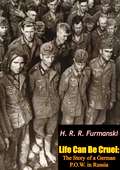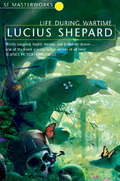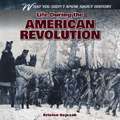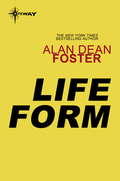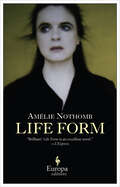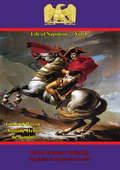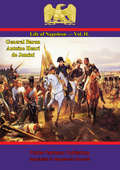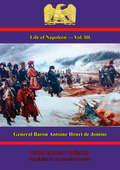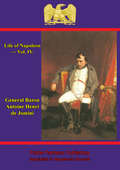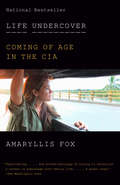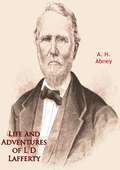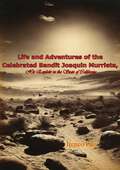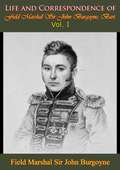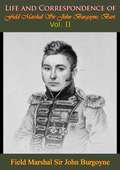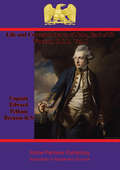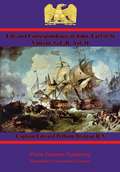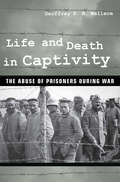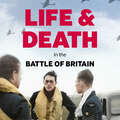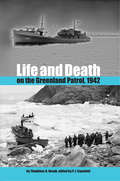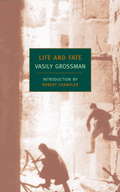- Table View
- List View
Life Can Be Cruel: The Story of a German P.O.W. in Russia
by H. R. R. FurmanskiOriginally published in 1960, this compact book tells the true story of a German soldier: from his early childhood during the First World War, through to his harrowing experiences on the frontline during the Word War II, culminating in his capture by the Red Army on 20 December 1942…An astonishing first-hand account.
Life During Wartime
by Lucius ShepardIn Guatemala, David is slugging it out the rotting vegetation and his despairing foot soldiers. Beyond the warzone, he meets Debora, who may be working for the enemy, and stumbles into a deadly psychic conflict where the mind is the greatest weapon.
Life During Wartime (S.F. MASTERWORKS)
by Lucius ShepardIn the jungles of Guatemala, David Mingolla is struggling to survive amongst the rotting vegetation and his despairing fellow foot soldiers. He knows he is nothing but an expendable pawn in an endless war. On R & R a few miles away from the warzone he meets Debora - an enigmatic young woman who may be working for the enemy - and stumbles into a deadly psychic conflict where the mind is the greatest weapon.
Life During the American Revolution (What You Didn't Know About History)
by Kristen RajczakThe American Revolution was full of odd events not usually included in history books. Some of these events include: the tar and feathering of British supporters and battles taking place in farmers fields. Readers will find many new and sometimes funny facts in this book, such as patriot soldiers leaving the war to harvest their crops. Surprising fact boxes and distinctive historical information engage readers with a unique look at the Revolutionary War.
Life Form
by Alan Dean FosterWhen a team of scientists starts to investigate the flora and fauna of the distant planet of Xica, it soon becomes apparent that this is a unique opportunity to study alien life forms. The planet offers a rich and varied eco-system and each of the scientists recognises what this could mean for their individual reputations.And then, their dreams come true - they establish first contact with a humanoid civilization.But this is a planet where nature breaks all the rules, where logic falls apart, and where nothing is as it seems. And their dreams turn into a nightmare.
Life Form
by Amélie NothombA fictional correspondence with a desperate American soldier leads to a strange new reality in this surreal novel of trauma, healing, and war.One morning, the heroine of this book—a famous Belgian author named Amélie Nothomb—receives an unusual fan letter. Melvin Mapple, an American soldier stationed in Iraq, tells her of the horrors around him. And of his only comfort, eating. He eats and eats until his ever-growing bulk starts to suffocate him. Disgusted with himself, but unable to stop, he labels his excess self Scheherazade as a way to cope.Repulsed yet fascinated by Mapple’s story, Nothomb begins exchanging letters with him. She opens up about her artistic process and the challenges of being in the spotlight. Their far-reaching conversation delves into universal questions about humanity and relationships. But their epistolary friendship takes a surprising turn when the novelist discovers bizarre facts lurking behind Mapple’s complex personal story.
Life Hacks for Military Spouses: Advice, Wit, and Humor from Those Who Served Behind the Scenes
by Tracey Enerson Wood Allison Wood Kristen RiffleA colorful collection of tips and tricks for getting the most out of the nomadic military lifestyle. Told through humorous anecdotes by those with years of unique experiences, these life hacks reveal a special culture with expectations and numerous obstacles to be faced along the way. Military life boasts of travel to exotic places, immersion in the worldly cultures, and cuisine that most Americans can only dream about . . . and on the government&’s dime, to boot! At least, that&’s what the common perception is. But those who have served know that while the above may be true, military life comes with its own set of challenges and can be a hardship as much as it is rewarding. Here to help is the advice, guidance, and personal stories of spouses from all walks of life, in stages from the newlywed to the retired and properly salty. They share tips on overcoming the numerous obstacles, and navigating the special culture, traditions, and the one-of-a-kind lingo of military service. Gathered mostly from those who are affiliated with the military, but also from those with similar diplomatic lifestyles, the anecdotes reveal the special bond they share with their fellow spouses, and the wisdom gained to pass to the next generation.The very special illustrations were created by a talented Air Force wife, and reflect both the strong beauty and earnestness of those who are engaged in our nation&’s most serious business, and yet, have learned not take themselves too seriously.
Life Of Napoleon — Vol. I. (Life Of Napoleon #1)
by General Baron Antoine Henri de Jomini General H. W. HalleckThe life of Napoleon is etched still across the history of Europe, in the wars he waged, the dynasties that he toppled, and the laws he enacted. Even in an epoch rich in social change, from the bottom up he remains a fascinating figure; biographers face the challenge of doing justice to such a multi-faceted character. Few can have been said to have access to the Emperor as much as the generals that served under him throughout his many campaigns; General Jomini spent many year serving the Emperor and many more in the company of some of his enemies putting him in an excellent position to write his biography. Written as if by Napoleon himself, Jomini traces Napoleon's political and military successes and failures, weaving them into a seamless narrative that makes his work one of the few rounded biographies of Napoleon.This first volume covers Napoleon's early years from birth in Ajaccio in Corsica to his ascent to the Consulship and the peace of Amiens in 1802.Of the Author -- General Jomini saw much service during the Napoleonic Wars, initially working in staff positions for Marshal Ney prior to being attached to the Emperor's own headquarters during the 1806 and 1807 campaigns. He was pushed out of the Grande Armée into the arms of the Russian service in 1813, becoming aide-de-camp to the Tzar. He was famous for his copious output of works on the military theory and strategy employed during the French Revolution, the Napoleonic Wars, and even those of Frederick the Great. He is often remembered for his chef d'œuvre, the "Art of War", and has been dubbed the "founder of modern strategy" by historian John Shy.Author -- General Baron Antoine Henri de Jomini (1779-1869)Translator -- General H. W. Halleck (1815-1872
Life Of Napoleon — Vol. II. (Life Of Napoleon #2)
by General Baron Antoine Henri de Jomini General H. W. HalleckThe life of Napoleon is etched still across the history of Europe, in the wars he waged, the dynasties that he toppled, and the laws he enacted. Even in an epoch rich in social change, from the bottom up he remains a fascinating figure; biographers face the challenge of doing justice to such a multi-faceted character. Few can have been said to have access to the Emperor as much as the generals that served under him throughout his many campaigns; General Jomini spent many year serving the Emperor and many more in the company of some of his enemies putting him in an excellent position to write his biography. Written as if by Napoleon himself, Jomini traces Napoleon's political and military successes and failures, weaving them into a seamless narrative that makes his work one of the few rounded biographies of Napoleon.This second volume covers the campaigns of Austerlitz, Jena, Eylau and Friedland and the beginnings of the Peninsular War.Of the Author -- General Jomini saw much service during the Napoleonic Wars, initially working in staff positions for Marshal Ney prior to being attached to the Emperor's own headquarters during the 1806 and 1807 campaigns. He was pushed out of the Grande Armée into the arms of the Russian service in 1813, becoming aide-de-camp to the Tzar. He was famous for his copious output of works on the military theory and strategy employed during the French Revolution, the Napoleonic Wars, and even those of Frederick the Great. He is often remembered for his chef d'œuvre, the "Art of War", and has been dubbed the "founder of modern strategy" by historian John Shy.Author -- General Baron Antoine Henri de Jomini (1779-1869)Translator -- General H. W. Halleck (1815-1872)
Life Of Napoleon — Vol. III. (Life Of Napoleon #3)
by General Baron Antoine Henri de Jomini General H. W. HalleckThe life of Napoleon is etched still across the history of Europe, in the wars he waged, the dynasties that he toppled, and the laws he enacted. Even in an epoch rich in social change, from the bottom up he remains a fascinating figure; biographers face the challenge of doing justice to such a multi-faceted character. Few can have been said to have access to the Emperor as much as the generals that served under him throughout his many campaigns; General Jomini spent many year serving the Emperor and many more in the company of some of his enemies putting him in an excellent position to write his biography. Written as if by Napoleon himself, Jomini traces Napoleon's political and military successes and failures, weaving them into a seamless narrative that makes his work one of the few rounded biographies of Napoleon.This third volume covers the campaigns of Wagram, the continuing Spanish Ulcer and the beginnings of the Russian campaign in 1812.Of the Author -- General Jomini saw much service during the Napoleonic Wars, initially working in staff positions for Marshal Ney prior to being attached to the Emperor's own headquarters during the 1806 and 1807 campaigns. He was pushed out of the Grande Armée into the arms of the Russian service in 1813, becoming aide-de-camp to the Tzar. He was famous for his copious output of works on the military theory and strategy employed during the French Revolution, the Napoleonic Wars, and even those of Frederick the Great. He is often remembered for his chef d'œuvre, the "Art of War", and has been dubbed the "founder of modern strategy" by historian John Shy.Author -- General Baron Antoine Henri de Jomini (1779-1869)Translator -- General H. W. Halleck (1815-1872)
Life Of Napoleon — Vol. IV. (Life Of Napoleon #4)
by General Baron Antoine Henri de Jomini General H. W. HalleckThe life of Napoleon is etched still across the history of Europe, in the wars he waged, the dynasties that he toppled, and the laws he enacted. Even in an epoch rich in social change, from the bottom up he remains a fascinating figure; biographers face the challenge of doing justice to such a multi-faceted character. Few can have been said to have access to the Emperor as much as the generals that served under him throughout his many campaigns; General Jomini spent many year serving the Emperor and many more in the company of some of his enemies putting him in an excellent position to write his biography. Written as if by Napoleon himself, Jomini traces Napoleon's political and military successes and failures, weaving them into a seamless narrative that makes his work one of the few rounded biographies of Napoleon.This fourth volume covers the disastrous effects of the Russian campaign, the fight in Germany of 1813, his downfall in 1814 and his final defeat at Waterloo.Of the Author -- General Jomini saw much service during the Napoleonic Wars, initially working in staff positions for Marshal Ney prior to being attached to the Emperor's own headquarters during the 1806 and 1807 campaigns. He was pushed out of the Grande Armée into the arms of the Russian service in 1813, becoming aide-de-camp to the Tzar. He was famous for his copious output of works on the military theory and strategy employed during the French Revolution, the Napoleonic Wars, and even those of Frederick the Great. He is often remembered for his chef d'œuvre, the "Art of War", and has been dubbed the "founder of modern strategy" by historian John Shy.Author -- General Baron Antoine Henri de Jomini (1779-1869)Translator -- General H. W. Halleck (1815-1872)
Life Sciences and Related Fields
by International Union of Biochemistry Molecular BiologyDuring the last decade, national and international scientific organizations have become increasingly engaged in considering how to respond to the biosecurity implications of developments in the life sciences and in assessing trends in science and technology (S&T) relevant to biological and chemical weapons nonproliferation. The latest example is an international workshop, Trends in Science and Technology Relevant to the Biological Weapons Convention, held October 31 - November 3, 2010 at the Institute of Biophysics of the Chinese Academy of Sciences in Beijing. Life Sciences and Related Fields summarizes the workshop, plenary, and breakout discussion sessions held during this convention. Given the immense diversity of current research and development, the report is only able to provide an overview of the areas of science and technology the committee believes are potentially relevant to the future of the Biological and Toxic Weapons Convention (BWC), although there is an effort to identify areas that seemed particularly ripe for further exploration and analysis. The report offers findings and conclusions organized around three fundamental and frequently cited trends in S&T that affect the scope and operation of the convention: The rapid pace of change in the life sciences and related fields; The increasing diffusion of life sciences research capacity and its applications, both internationally and beyond traditional research institutions; and The extent to which additional scientific and technical disciplines beyond biology are increasingly involved in life sciences research. The report does not make recommendations about policy options to respond to the implications of the identified trends. The choice of such responses rests with the 164 States Parties to the Convention, who must take into account multiple factors beyond the project's focus on the state of the science.
Life Undercover: Coming of Age in the CIA
by Amaryllis Fox“Fast and thrilling . . . Life Undercover reads as if a John le Carré character landed in Eat Pray Love." —The New York Times <P><P>Amaryllis Fox's riveting memoir tells the story of her ten years in the most elite clandestine ops unit of the CIA, hunting the world's most dangerous terrorists in sixteen countries while marrying and giving birth to a daughter <P><P>Amaryllis Fox was in her last year as an undergraduate at Oxford studying theology and international law when her writing mentor Daniel Pearl was captured and beheaded. <P><P>Galvanized by this brutality, Fox applied to a master's program in conflict and terrorism at Georgetown's School of Foreign Service, where she created an algorithm that predicted, with uncanny certainty, the likelihood of a terrorist cell arising in any village around the world. <P><P>At twenty-one, she was recruited by the CIA. Her first assignment was reading and analyzing hundreds of classified cables a day from foreign governments and synthesizing them into daily briefs for the president. Her next assignment was at the Iraq desk in the Counterterrorism center. At twenty-two, she was fast-tracked into advanced operations training, sent from Langley to "the Farm," where she lived for six months in a simulated world learning how to use a Glock, how to get out of flexicuffs while locked in the trunk of a car, how to withstand torture, and the best ways to commit suicide in case of captivity. <P><P> At the end of this training she was deployed as a spy under non-official cover--the most difficult and coveted job in the field as an art dealer specializing in tribal and indigenous art and sent to infiltrate terrorist networks in remote areas of the Middle East and Asia. <P><P>Life Undercover is exhilarating, intimate, fiercely intelligent--an impossible to put down record of an extraordinary life, and of Amaryllis Fox's astonishing courage and passion. <P><P><b>A New York Times Bestseller</b>
Life Undercover: Coming of Age in the CIA
by Amaryllis FoxAmaryllis Fox's riveting memoir tells the story of her ten years in the most elite clandestine ops unit of the CIA, hunting the world's most dangerous terrorists in sixteen countries while falling in love and giving birth to a daughter.Amaryllis Fox was in her last year as an undergraduate at Oxford studying ancient languages and theoretical physics when her writing mentor, Daniel Pearl, was captured and beheaded. Galvanized by this brutality, she applied to a Master's program in conflict and terrorism at Georgetown's School of Foreign Service, where she created an algorithm that predicted, with uncanny certainty, the likelihood of a terrorist cell arising in any village around the world. At 21, she was recruited by the CIA. Her first assignment was reading and analyzing hundreds of classified cables a day from foreign governments and synthesizing them into daily briefs for the President. Her next assignment was at the Iraq desk in the Counterterrorism center. At 22, she was fast-tracked into advanced operations training, sent from Langley to "the Farm," where she lived for six months in a simulated world learning how to use a glock, how to get out of flexicuffs while locked in the trunk of a car, how to withstand torture, and the best ways to commit suicide in case of captivity. At the end of this training she was deployed as a spy under non-official cover--the most difficult and coveted job in the field--as an art dealer specializing in tribal and Indigenous art, and sent to infiltrate terrorist networks in remote areas of the Middle East and Asia. Life Undercover is exhilarating, intimate, fiercely intelligent--an impossible-to-put-down record of an extraordinary life, and of Amaryllis Fox's astonishing courage and passion.
Life and Adventures of L D Lafferty: Being A True Biography of One of the Most Remarkable Men of the Great Southwest
by A. H. AbneyThe story chronicles the escapades of Lafferty through the Louisiana, Missouri and Arkansas Territories, the lands of the Old Settler Cherokees, and into the new frontier of Texas."L. D. Lafferty has been described as a rough ashlar of reckless daring and thoughtless intrepidity and a youthful adventurer who had fought Indians at the age of 15." - We Never Retreat: Filibustering Expeditions into Spanish Texas (2015)"L. D. Lafferty, a contemporary of Lafitte's, recalled that Lafitte frankly confessed that he had enough silver and gold on the island to freight a ship." -Mysteries and Legends of Texas (2010)"Lorenzo Dow Lafferty, son of a Tennessee Indian trader who followed the Cherokees to Arkansas in 1810, spent three of his teenage years (1815-1818) living in a Cherokee town on the White River." -The Arkansas Historical Quarterly (1997)
Life and Adventures of the Celebrated Bandit Joaquin Murrieta, His Exploits in the State of California
by Ireneo PazDelve into the legendary tale of one of California's most infamous figures with Ireneo Paz's Life and Adventures of the Celebrated Bandit Joaquin Murrieta: His Exploits in the State of California. This riveting narrative brings to life the story of Joaquin Murrieta, a Mexican bandit whose name became synonymous with rebellion and justice during the tumultuous Gold Rush era.Ireneo Paz, a masterful storyteller, combines meticulous research with vibrant prose to paint a comprehensive portrait of Murrieta's life. From his humble beginnings to his rise as a feared and admired outlaw, the book explores the socio-political landscape of mid-19th century California, marked by racial tensions, economic upheaval, and the quest for fortune.Through detailed accounts of Murrieta's daring escapades, readers will be captivated by the daring heists, narrow escapes, and the relentless pursuit by law enforcement. Paz delves into the motivations behind Murrieta's transformation from a victim of injustice to a symbol of resistance, capturing the complexities of his character and the era he lived in.Life and Adventures of the Celebrated Bandit Joaquin Murrieta is not just a tale of crime and retribution; it is a poignant exploration of identity, resilience, and the human spirit. Paz's vivid descriptions and compelling storytelling offer a window into the cultural and historical context that shaped Murrieta's legend, making this book an essential read for history enthusiasts, adventure seekers, and anyone fascinated by the rich tapestry of California's past.Join the adventure and uncover the truth behind the myth of Joaquin Murrieta, a man whose legacy continues to intrigue and inspire.
Life and Correspondence of Field Marshal Sir John Burgoyne, Bart. — Vol. I (Life and Correspondence of Field Marshal Sir John Burgoyne, Bart. #1)
by George Wrottesley R.E. Field Marshal Sir John Burgoyne Bart.This ebook is purpose built and is proof-read and re-type set from the original to provide an outstanding experience of reflowing text for an ebook reader. Sir John Fox Burgoyne, illegitimate child of General John Burgoyne, started life with few prospects of greatness but ended his life as a hugely respected Field Marshal of the British army; his funeral in 1871 was attended by no less than "Her Majesty the Queen, H.R.H. the Prince of Wales, H.R.H. the Duke of Edinburgh, H.R.H. Prince Arthur, His Majesty the King of the Belgians... Among the British Officers assembled, were two Field-Marshals, ten full Generals, of whom seven wore the insignia of Grand Cross of the Bath, three Lieut.-Generals, fifteen Major-Generals, including Prince Edward of Saxe Weimar..." Destined for a military career from birth, he was commissioned into the Royal Engineers on 29th August 1798. At the time the Royal Engineers were a small body of men with specialized knowledge, primarily commissioned officers with few enlisted men - even a new Lieutenant was a person of consequence due to his rarity and skills, and the paucity of advancement that relied purely on seniority of service. He did not have to wait long before being flung into action during the blockade of Malta and then the invasion of Denmark. However, the majority of this book consists of letters and journal entries of his experiences during the Peninsular War. As one of the few engineers with the Duke's army, he was given important assignments during the sieges that dominated the movements of the Allied forces; his notes are all the more important for their commentary of the siege operations such as Badajoz and Ciudad Rodrigo that were undertaken from his expert knowledge. Notwithstanding the high casualty rates amongst the Engineers, Sir John survived the War to be employed on the disastrous expedition to New Orleans in 1814. His post-Napoleonic career was stunted by lack of potential advancement, so much so that he became involved in civil engineering and work on fortifications. He was posted to Ireland where he endeavoured to improve the conditions of the poor, particularly straining all his influence during the disastrous potato famine. Whilst doing this he was also a frequent correspondent with the military establishment over improvements and clashed with the indifference of politicians and their budgets. The first volume ends with the beginnings of the tension with Russia and his coming employment in the Crimea. Title - Life and Correspondence of Field Marshal Sir John Burgoyne, Bart. -- Vol. I Series Name - Life and Correspondence of Field Marshal Sir John Burgoyne, Bart. Series Number -- I Author -- Field Marshal Sir John Burgoyne, Bart.(1782-1871) Editor -- Lieut.-Colonel the Hon. George Wrottesley (R.E.) (1827-1909) Text taken, whole and complete, from the edition published in 1873, London, by Richard Bentley. Original - 506 pages. Illustrations - one portrait.
Life and Correspondence of Field Marshal Sir John Burgoyne, Bart. — Vol. II (Life and Correspondence of Field Marshal Sir John Burgoyne, Bart. #2)
by George Wrottesley R.E. Field Marshal Sir John Burgoyne, Bart.In this second volume Field Marshal Burgoyne letters and correspondence describe his service during the Crimean War and his later life. By the time of the conflict in Russian Sir John was inspector-general of fortifications and a major-general; he was assigned to the expedition as the chief engineering advisor to Lord Raglan. He accompanied Lord Raglan's headquarters to the East, superintended the disembarkation at Old Fort, and was in effect the principal engineer adviser to the English commander during the first part of the siege of Sevastopol. He was recalled early in 1855, and though he was at first bitterly criticized by the public for his part in the earlier and unsuccessful operations against the fortress, the wisdom of his advice was ultimately recognized. In 1856 he was created a baronet, and promoted to the full rank of general. In 1858 he was present at the second funeral of Napoleon I. as Queen Victoria's representative, and in 1865 he was made constable of the Tower of London. Three years later, on resigning his post as inspector-general of fortifications, he was made a field marshal. Parliament granted him, at the same time, a pension of £1500. He died on the 7th of October 1871, a year after the tragic death of his only son, Captain Hugh Talbot Burgoyne, V.C. (1833-1870), who was in command of H.M.S. "Captain" when that vessel went down in the Bay of Biscay (September 7, 1870).
Life and Correspondence of John, Earl of St Vincent, G.C.B. Vol. I: Admiral of the Fleet &C. &C. & C. (Life and Correspondence of John, Earl of St Vincent, G.C.B. #1)
by Captain Edward Pelham Brenton R.N.This ebook is purpose built and is proof-read and re-type set from the original to provide an outstanding experience of reflowing text for an ebook reader. Earl St. Vincent was not only an excellent administrator, a fine sailor and undaunted defender of the Royal Navy. He was also eclipsed in the tomes of history by his more famous protégé, Lord Nelson. Sir John Jervis had served for many years with distinction before Nelson's birth; defending Jamaica from privateers and pirates, distinguishing himself during the Seven Years war and War of American Independence. This two-volume biography by Captain Brenton, a contemporary (albeit junior) of both naval heroes, goes some way to fixing the void in the record of Earl St Vincent. The biography includes much of the original documentation and letters of the period when the invasion of the British isles was a real possibility as the French and Spanish turned from enemies to allies and joined their naval might together. At that time Sir John Jervis was in command of squadrons in the Channel, as he had been beforehand in the Mediterrean, enforcing a blockade that strangled the commerce of Spain and France. During those times that ships escaped port, Jervis and his subordinates hunted them without mercy, the most striking example being the battle of St. Vincent. Although outnumbered by his Spanish opponents, Sir John led fifteen of his ships on. The following anecdote is told of the initial contact before the battle: "There are eight sail of the line, Sir John" "Very well, sir" "There are twenty sail of the line, Sir John" "Very well, sir" "There are twenty five sail of the line, Sir John" "Very well, sir" "There are twenty seven sail of the line, Sir John" "Enough, sir, no more of that; the die is cast, and if there are fifty sail I will go through them" His entry in the Oxford Dictionary of National Biography states that -- "His importance lies in his being the organizer of victories; the creator of well-equipped, highly efficient fleets; and in training a school of officers as professional, energetic, and devoted to the service as himself." An excellent and detailed read. Title - Life and Correspondence of John, Earl of St Vincent, G.C.B. Vol. I Sub-Title - Admiral of the Fleet &C. &C. & C. Series Name - Life and Correspondence of John, Earl of St Vincent, G.C.B. Series Number -- 1 Author -- Captain Edward Pelham Brenton R.N. (1770-1844) Text taken, whole and complete, from the edition published in two volumes 1838, London, by H. Colbourn. Original - viii and 500 pages. Illustrations - one portrait.
Life and Correspondence of John, Earl of St Vincent, G.C.B. Vol. I: Admiral of the Fleet &C. &C. & C. (Life and Correspondence of John, Earl of St Vincent, G.C.B. #2)
by Captain Edward Pelham Brenton R.N.This ebook is purpose built and is proof-read and re-type set from the original to provide an outstanding experience of reflowing text for an ebook reader. Earl St. Vincent was not only an excellent administrator, a fine sailor and undaunted defender of the Royal Navy. He was also eclipsed in the tomes of history by his more famous protégé, Lord Nelson. Sir John Jervis had served for many years with distinction before Nelson's birth; defending Jamaica from privateers and pirates, distinguishing himself during the Seven Years war and War of American Independence. This two-volume biography by Captain Brenton, a contemporary (albeit junior) of both naval heroes, goes some way to fixing the void in the record of Earl St Vincent. The biography includes much of the original documentation and letters of the period when the invasion of the British isles was a real possibility as the French and Spanish turned from enemies to allies and joined their naval might together. At that time Sir John Jervis was in command of squadrons in the Channel, as he had been beforehand in the Mediterrean, enforcing a blockade that strangled the commerce of Spain and France. During those times that ships escaped port, Jervis and his subordinates hunted them without mercy, the most striking example being the battle of St. Vincent. Although outnumbered by his Spanish opponents, Sir John led fifteen of his ships on. The following anecdote is told of the initial contact before the battle: "There are eight sail of the line, Sir John" "Very well, sir" "There are twenty sail of the line, Sir John" "Very well, sir" "There are twenty five sail of the line, Sir John" "Very well, sir" "There are twenty seven sail of the line, Sir John" "Enough, sir, no more of that; the die is cast, and if there are fifty sail I will go through them" His entry in the Oxford Dictionary of National Biography states that -- "His importance lies in his being the organizer of victories; the creator of well-equipped, highly efficient fleets; and in training a school of officers as professional, energetic, and devoted to the service as himself." An excellent and detailed read. Title - Life and Correspondence of John, Earl of St Vincent, G.C.B. Vol. II Sub-Title - Admiral of the Fleet &C. &C. & C. Series Name - Life and Correspondence of John, Earl of St Vincent, G.C.B. Series Number -- 2 Author -- Captain Edward Pelham Brenton R.N. (1770-1844) Text taken, whole and complete, from the edition published in two volumes 1838, London, by H. Colbourn. Original - xii and 418 pages. Illustrations - one map.
Life and Death in Captivity: The Abuse of Prisoners during War
by Geoffrey P. WallaceWhy are prisoners horribly abused in some wars but humanely cared for in others? In Life and Death in Captivity, Geoffrey P. R. Wallace explores the profound differences in the ways captives are treated during armed conflict. Wallace focuses on the dual role played by regime type and the nature of the conflict in determining whether captor states opt for brutality or mercy. Integrating original data on prisoner treatment during the last century of interstate warfare with in-depth historical cases, Wallace demonstrates how domestic constraints and external incentives shape the fate of captured enemy combatants. Both Russia and Japan, for example, treated prisoners very differently in the Russo-Japanese War of 1904–5 and in World War II; the behavior of any given country is liable to vary from conflict to conflict and even within the same war. Democracies may be more likely to treat their captives humanely, yet this benevolence is rooted less in liberal norms of nonviolence than in concerns over public accountability. When such concerns are weak or absent, democracies are equally capable of brutal conduct toward captives. In conflicts that devolve into protracted fighting, belligerents may inflict violence against captives as part of a strategy of exploitation and to coerce the adversary into submission. When territory is at stake, prisoners are further at risk of cruel treatment as their captors seek to permanently remove the most threatening sources of opposition within newly conquered lands. By combining a rigorous strategic approach with a wide-ranging body of evidence, Wallace offers a vital contribution to the study of political violence and wartime conduct.
Life and Death in the Battle of Britain
by Carl WarnerGuy Mayfield was the Station Chaplain at RAF Duxford during the Battle of Britain. His diary is a moving account of the war fought by the young pilots during that summer of 1940, providing a unique and intimate insight into one of the most pivotal moments in British history.Frequently speaking to pilots who knew they may not survive the next 24 hours, Mayfield's diary provides a vivid account of the fears and hopes of the young men who risked their lives daily for the defence of Britain. Interspersed with photographs of the men and contextual narrative by IWM historian Carl Warner, this book brings a compelling and direct new perspective to this historic battle.(P)2019 Headline Publishing Group Ltd
Life and Death on the Greenland Patrol, 1942 (New Perspectives on Maritime History and Nautical Archaeology)
by Thaddeus NovakOne of the untold stories of World War II is the guarding of Greenland and its coastal waters, where the first U.S. capture of an enemy ship took place. For six months in 1942 and against standing orders of the time, Thaddeus Nowakowski (now Novak) kept a personal diary of his service on patrol in the North Atlantic. Supplemented by photos from his last surviving shipmates, Novak’s diary fills a void in the story of American sailors at war in the North Atlantic. It is the only known diary of an enlisted Coast Guard sailor to emerge from WWII.
Life and Fate
by Robert Chandler Vasily GrossmanA book judged so dangerous in the Soviet Union that not only the manuscript but the ribbons on which it had been typed were confiscated by the state, Life and Fate is an epic tale of World War II and a profound reckoning with the dark forces that dominated the twentieth century. Interweaving a transfixing account of the battle of Stalingrad with the story of a single middle-class family, the Shaposhnikovs, scattered by fortune from Germany to Siberia, Vasily Grossman fashions an immense, intricately detailed tapestry depicting a time of almost unimaginable horror and even stranger hope.Life and Fate juxtaposes bedrooms and snipers' nests, scientific laboratories and the Gulag, taking us deep into the hearts and minds of characters ranging from a boy on his way to the gas chambers to Hitler and Stalin themselves. This novel of unsparing realism and visionary moral intensity is one of the supreme achievements of modern Russian literature.
Life and Letters of Harriet Beecher Stowe
by Annie FieldsHarriet Beecher Stowe (1811-1896) became famous almost overnight when "Uncle Tom's Cabin" - which sold more than 300,000 copies in its first year of publication—appeared in 1852. Known by virtually all famous writers in the United States and many in England and regarded by many women writers as a role model because of her influence in the literary marketplace, Stowe herself was the subject of many books, articles, essays, and poems during her lifetime.
